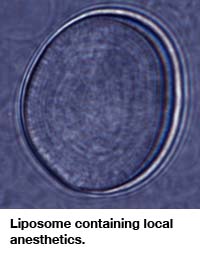In a discovery that could revolutionize the treatment of chronic and surgery-related pain, researchers at Children’s Hospital Boston have created a new system of slow-release delivery for anesthetic drugs, producing long-lasting local anesthesia in rats without signs of toxicity in their nerve or muscle cells.
The research, funded by the National Institutes of Health, is published online in the Proceedings of the National Academy of Sciences.
“The idea was to have a single injection that could produce a nerve block lasting days, weeks, maybe even months,” lead author Daniel Kohane, of the hospital’s Division of Critical Care Medicine in the department of anesthesiology, was quoted in a press release announcing the findings. “It would be useful for conditions like chronic pain where, rather than use narcotics, which are systemic and pose a risk of addiction, you could just put that piece of the body to sleep, so to speak.”

Earlier efforts to develop slow-release anesthetics have been thwarted by the tendency of conventional drugs to cause toxicity in the surrounding tissue. But Kohane and colleagues report that if a potent anesthetic, saxitoxin, is packaged within specially designed fat-based particles called liposomes, it is able to block pain transmissions from nerves without causing significant muscle damage.
Further cell culture experiments and tissue analysis confirmed that the concoctions were not toxic to muscle or nerve cells. And when the team examined four genes known to be correlated with nerve injury, they found no increase in expression.
“If these long-acting, low-toxicity formulations of local anesthetics are shown to be effective in humans, they could have a major impact on the treatment of acute and chronic pain,” added Alison Cole of the NIH’s National Institute of General Medical Sciences, in the press release. “This slow-release technology may also have broader applications in drug delivery for the treatment of a variety of diseases.”
Kohane, who is currently optimizing the formulation to achieve the greatest duration while still avoiding local and systemic toxicity, added: “It is conceivable we could have a formulation that is suitable for clinical trials before too long.”
Sign up for our free e-newsletter.
Are you on Facebook? Become our fan.




